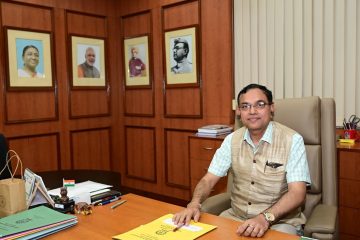 Can there be looking ahead without looking back? The 73rd Independence Day of India could be a good time to ask the question. But as Prof. Anjali Roy’s just-released book on the ‘memories and post memories of Partition’ makes obvious, the question is a complicated one, for looking back itself is a complicated task.
Can there be looking ahead without looking back? The 73rd Independence Day of India could be a good time to ask the question. But as Prof. Anjali Roy’s just-released book on the ‘memories and post memories of Partition’ makes obvious, the question is a complicated one, for looking back itself is a complicated task.
 One reason that has complicated the ‘looking back’ at Partition –a fact of history indissociable from Independence – is the deafening silence surrounding it. Part of this is because of the conscious erasure of the disturbing memories of Partition in order to promote the triumphalist narrative of Indian Independence that focuses on a few figures, such as Gandhi, Mountbatten, Jinnah, Nehru and others. The other is the survivors’ deliberate concealment of Partition traumas.
One reason that has complicated the ‘looking back’ at Partition –a fact of history indissociable from Independence – is the deafening silence surrounding it. Part of this is because of the conscious erasure of the disturbing memories of Partition in order to promote the triumphalist narrative of Indian Independence that focuses on a few figures, such as Gandhi, Mountbatten, Jinnah, Nehru and others. The other is the survivors’ deliberate concealment of Partition traumas.
Unspecified, shadowy rules that forbid the sharing individual or family secrets, except in the intimate space of the family and that too under the right circumstances, appear to prevent survivors from sharing their past, especially its painful memories. But the acceleration of memory discourses in the West following the archiving of the Holocaust memories, the broadening of debate on Partition itself and perhaps anxiety and a sense of duty as the Partition witnesses age, die and peter away, have triggered what Roy calls an “insatiable Partition industry”.

She does not dismiss the importance of the ‘memory turn’ in Partition studies that foregrounds individual and collective memories of Partition survivors in providing an alternative understanding of Partition, but she cautions, “…the difference in remembering, memory and forgetting in archival, oral and survivor accounts of the event has not been engaged with in sufficient depth.”
Drawing on the recent debates in history, memory, postmemory and trauma, Roy tries to uncover the afterlife of Partition. The book looks at the processes of memory and postmemory in the silence and remembering of Partition by both the adult survivors of Partition and those who were children during the time and grew up listening about that event.

Through the narratives of predominantly middle class, upper caste Hindu and Sikh survivors displaced by Partition-in-the-west, she shows how the survivors and their children “script and emplot their life-stories”. What is a tragic tale of haplessness and abjection becomes, through their retelling, a story of personal triumph, fortitude, resilience, industry, enterprise and success. And yet, the silences, stutters and stammers in these retellings also bring to light the untold stories of traumatic experiences – as they settle down in strange lands, into new habits and sometimes new languages – that are repressed in a consensual narrative constructed by survivors and their families.
Even while she upholds ‘memory histories’ (or shared experiences that feed collective memories) in providing an alternative and a closer view of Partition, she points out that Partition historians have “unintentionally created a macro-history of Partition.” In this version, the Punjab experience (and often an irreconcilably communal one where Hindus and Sikhs are only seen as victims of Muslim violence) has become a universal trope for theorizing the Partition experience. But Partition-in-the-west was not a one-time exchange of populations. As her book points out by charting the tortuous itineraries of several of these people, Punjabi refugees were forced to resettle in parts of Himachal Pradesh, Haryana, Uttar Pradesh, Bihar, Jharkhand, Madhya Pradesh and even in the deep South, by drawing on state as well as filial networks.

She says, “Through reconstructing these microhistories, it [the book] hopes to show that Partition-in-the-west, as in the east, was not one uniform experience shared by all those who crossed the border from the west but varied according to gender, class, caste, ethnicity, region, education, profession, mode of transport and place of settlement.”
The two distinctive things about this shared memory are that survivors invariably “indulge in both willing forgetfulness or selective remembering” in constructing it, and two, this memory lives ‘in the intimacy of a collective heritage’ and is transmitted through everyday practices or rituals rather than verbally. Roy says, “Memory equally takes root in the performance of remembered rites of piety and conviviality in forgotten festivals and celebrations, language, food, dress, comportment, gestures, movements of the body, and even everyday practices, in the private space of the home as well as in the use of public space.” The new home could thus reconstructed either as language, as culture, as forms of sociality or rituals and as everyday practices.
An analysis of the postmemories of the witnesses who were children or teenagers at the time of Partition shows that they too bore the abiding effects of the horror and displacement of Partition. The experience transformed their perspectives, priorities, attitudes, much of this manifesting in habits and everyday practices transmitted over generations. Thus these too require detailed historical examination.
In the concluding chapter, “Partitioned beings”, Roy concludes claiming that the event of Partition constructs a particular partitioned subjectivity that subsumes earlier markers of identity such as language, religion, caste, ethnicity, region to converge on the event of Partition and the struggle to make life anew.
Graphics : Suman Sutradhar



